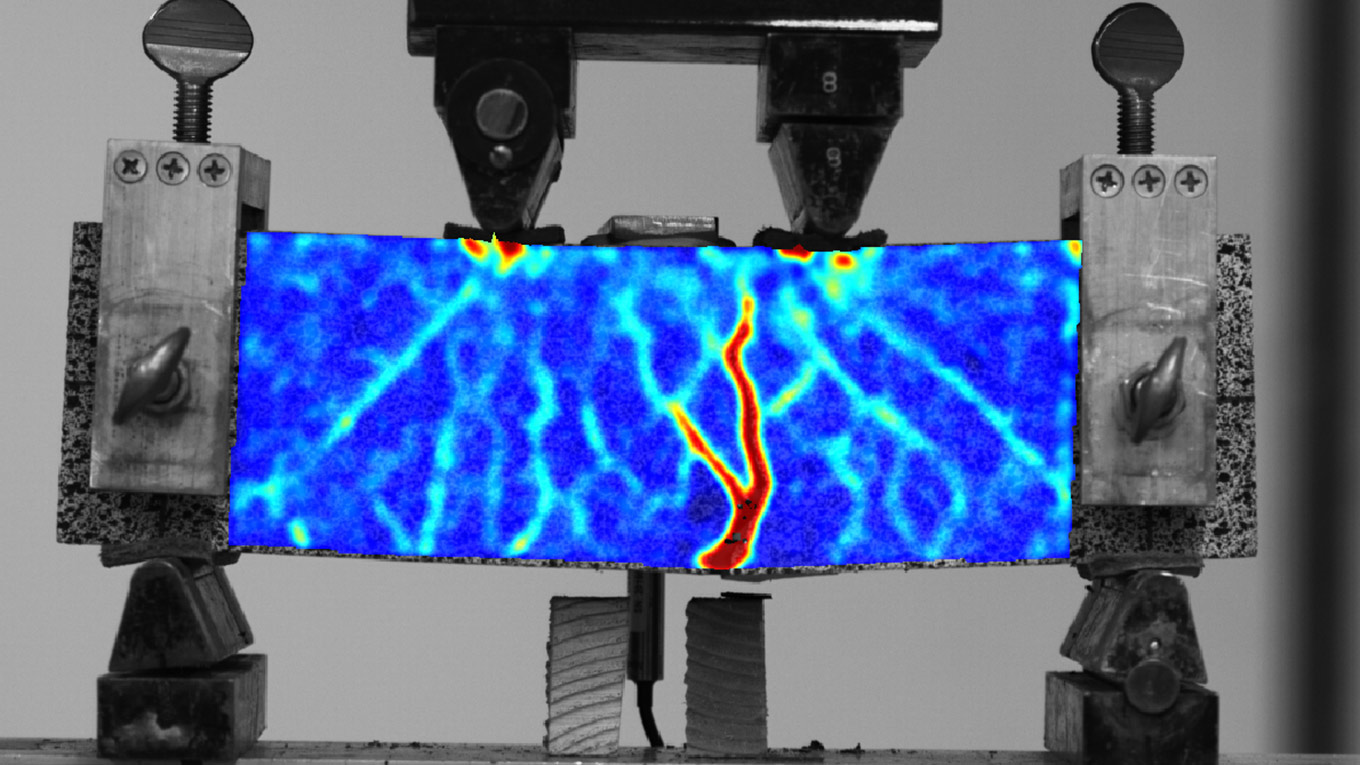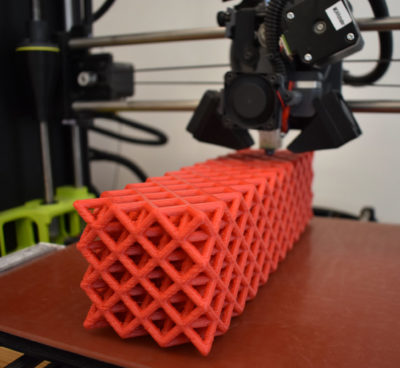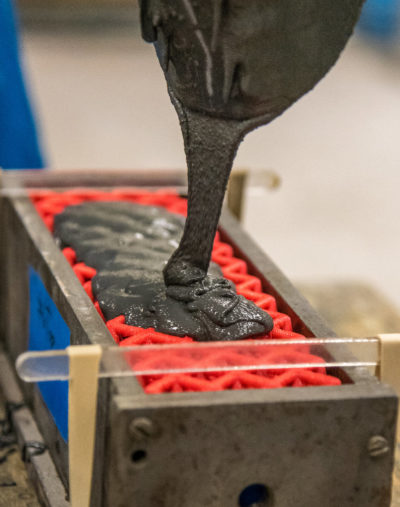Berkeley researchers use 3D printer to make stronger, greener concrete

Researchers at UC Berkeley have developed a new way to reinforce concrete with a polymer lattice, an advance that could rival other polymer-based enhancements and improve concrete’s ductility while reducing the material’s carbon emissions.
The Berkeley team used a 3D printer to build octet lattices out of polymer, and then filled them with ultra-high performance concrete (UHPC), which is four times stronger than conventional concrete in compression. The reinforced material performed well in tests of compression and four-point bending
The technique, reported in the November issue of the journal Materials and Design, could increase the appeal of concrete, one of the most widely used man-made building materials and one of the world’s most consumed substances — second only to water. It is cheap, abundant and strong in compression, capable of withstanding immensely heavy loads.
But concrete is notoriously weak in tension, or flexure. It is brittle and will begin to crack when pulled apart. Without reinforcement, a concrete structure could experience catastrophic failure and shatter without warning.
Since the mid-19th century, engineers have reinforced concrete with steel rebar. But steel’s strength comes with some downsides: It is heavy, expensive to produce, labor-intensive to install and degrades over time. Today, there’s a growing community of engineers exploring the potential to reinforce concrete with polymers, which are appealing to researchers because they are lightweight, don’t corrode and, due to an abundance of recyclable materials, could be cheap to produce.
“When a material is brittle, it can hold up to a certain peak load and then it fails,” said study co-author Claudia Ostertag, professor of civil and environmental engineering. “In this case, we did not observe that failure. It got stronger and stronger. For us interested in concrete, this is amazing. You are rendering something very brittle into something very ductile.”
Since the 1960s, engineers have reinforced concrete with polymer fibers. The concept isn’t new. Fibers have been used to reinforce mortar since ancient times — think of the straw added to adobe bricks. But they’re not a perfect solution. Fibers are mixed into concrete before it is poured and are rarely homogeneously distributed. This means one part of a structure might have a high concentration of fibers, while another has barely any, leaving a path for cracks to form.
The benefit of a lattice reinforcement is that a series of trusses stops cracks before they grow too large.
“Cracks are very clever,” Ostertag said. “They will choose the path of least resistance. However, in this case the cracks are no longer able to avoid the reinforcement due to its uniform 3D arrangement.”
Previous experiments of polymer lattice reinforcements pulled inspiration from the natural world, including the inner portion of abalone shells and the honeycomb shape of beehives. But those reinforcements were two-dimensional, which limited their ability to support complex concrete designs.

To produce a 3D design that could support heavy loads from all directions — what engineers call isotropic — the Berkeley researchers used the octet truss for the lattice structure. Popularized by the architect Buckminster Fuller in the 1950s, the octet truss is known for its ability to be both strong and incredibly light. In the early 1900s, Alexander Graham Bell used it to make kites.
The project builds off of previous research from Ostertag, whose lab first came up with the idea of using the octet-lattice structure with ultra-high performance concrete. Hayden Taylor, assistant professor of mechanical engineering, is the new study’s corresponding author, and Brian Salazar, a Ph.D. student in mechanical engineering, is the lead author.
The team tested two different polymers: polylactic acid (PLA), which is easy to 3D print but more brittle than other polymers, and acrylonitrile butadiene styrene (ABS), which is tougher than PLA and used in everything from Lego bricks and motorcycle helmets to whitewater canoes and car bumpers. Switching from PLA to ABS made no significant difference in compressive tests; all of the lattice-reinforced concrete samples scored high in strain density values, meaning they were able to absorb a lot of energy.

The engineers also experimented with the amount of lattice reinforcements used in the concrete. One sample was thinner, with the polymer making up 19.2% of a sample’s volume. The other made up 33.7%. While increasing the amount of polymer in the samples slightly decreased their compressive strength, it increased their peak loads. Importantly, the amount of polymer didn’t significantly change the structure’s overall mechanical properties. The samples with less polymer were just as tough as those with more.
But there are some instances where more polymer might have significant benefits.
Manufacturing cement, the main ingredient in concrete, produces 8% of the world’s carbon dioxide emissions. Reinforcement material makes up less than 5% of most concrete structures. So, increasing the amount of polymer — and reducing the amount of concrete — could cut down on a structure’s overall carbon emissions.
“The reaction that produces cement inherently produces CO2,” said Taylor. “In contrast, there is a conceivable route toward polymers that are net carbon-neutral or even potentially carbon-negative through the use of biopolymers, recycling and renewable energy sources.”
A next step, Salazar said, will be to determine if different concrete uses would be better served by different lattice shapes. In the future, engineers might determine the best reinforcement geometry for a given project with the help of topology optimization software.
“Going forward, my biggest question is how to choose the best lattice structure for a particular application,” Salazar said. “There could be even more optimal geometries waiting to be found.”
Other study co-authors include Parham Aghdasi and Ian Williams from the Department of Civil and Environmental Engineering.
This research was funded by a grant to the Berkeley Education Alliance for Research in Singapore (BEARS) for the Singapore-Berkeley Building Efficiency and Sustainability in the Tropics Program.
